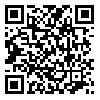BibTeX | RIS | EndNote | Medlars | ProCite | Reference Manager | RefWorks
Send citation to:
URL: http://tumj.tums.ac.ir/article-1-489-en.html
Background: Adenosine receptors play an important role in the treatment of paroxysmal supraventricular tachycardia in cardiovascular system. This effect is through interaction with A1 type of G-protein-coupled adenosine receptors. The effect of N6-cyclopentyladenosine (CPA), an A1-selective adenosine agonist, was studied on ouabain-induced toxicity in spontaneously beating isolated guinea pig atria.
Methods: In the beginning the isolated guinea pig atria were mounted on the organ bath containing modified krebs and contractile responses in the four groups (shame, CPA, ouabain, CPA- ouabain) were measured.
Results: CPA (2-16nM) produced a dose-dependent decrease in the force of contractions (34%-51%) and in the rate of contractions (22%-48%). CPA significantly increased the time of onset of arrhythmia (toxicity) induced by ouabain (1.2µM) when it was administered 10 min before ouabain was added in organ bath. Ouabain (1.2µM) alone produced arrhythmia at 7 min and either asystole or standstill at 22 min. CPA (8nM) increased the time required to produce arrhythmia to 27.5 min and prolonged beating atria to more than 63 min and prevented the occurrence of asystole.
Conclusion: CPA produces direct cardiac action, probably due the inhibition of cardiac Ca2+ channel and membrane hyperpolarization of atrium cells in guinea pig atria. Moreover, our results suggest that CPA may reduce the membrane conduction through inhibition of ionic channels, which decrease ouabain- induced toxicity.
| Rights and permissions | |
 |
This work is licensed under a Creative Commons Attribution-NonCommercial 4.0 International License. |





